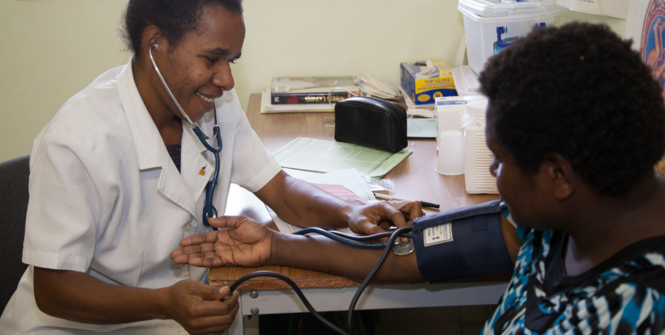Climate Change and Public Health in the Pacific

Climate change is the greatest threat to human health and development today and renders Pacific Island nations vulnerable to worsening health conditions.
The risk amplification of climate change as a threat to global physical, social, economic and environmental development has been recognised in the recently created Sustainable Development Goals (SDGs), which implores party states to ‘take urgent action to combat climate change and its impacts’.
Pacific Island nations are particularly vulnerable to the effects of climate change on human health by nature of their relatively small landmasses, largely underdeveloped and agrarian communities and their cultural and economic dependence on coastal environments. Their health systems are already largely overrun due to the burdens of infections and chronic non-communicable diseases (NCDs), and all projections point to climate change compounding these problems and magnifying the demands on resource-poor national budgets.
For these reasons, the nexus of climate change and its negative impacts on health needs to be addressed in the context of implementing universal development agreements such as the SDGs and in the development aid agenda of donor countries operating in the Pacific region, such as Australia.
Non-communicable diseases, nutrition and obesity
In light of genetic predispositions and post-colonial Pacific lifestyles, the burden of NCDs poses a ‘human, social and economic crisis requiring an urgent and comprehensive response’. NCDs include chronic cardiovascular disease, chronic lung diseases, cancer, diabetes and mental illness and share four common risk factors of physical inactivity, poor nutrition, tobacco smoking and the harmful consumption of alcohol.
NCDs are a massive spectre of morbidity and mortality in the Pacific Islands, accounting for almost 70-75 percent of all deaths. Of these, many are premature (before 60 years of age) and preventable. Much of this burden can be attributed to a high prevalence of diabetes and obesity among Pacific Island peoples. Of all nations in the world, eight of the top ten countries for diabetes prevalence are Pacific Island nations with comparative prevalence rates of 20-40 percent of the population.
Climate change threatens to accelerate some of the risk factors leading to and health complications derived from NCDs. Inadequate exercise, coupled with inappropriate diets resulting in caloric surplus, are deemed to be major mechanisms for developing diabetes and heart diseases through the storage of excess ingested energy as body fat.
It is presumed that these behaviours will become more prominent in light of climate change. Extremes of heat and hotter daily average atmospheric temperatures will lead to a deepening of sedentary behaviours due to discomfort in the heat. The nutrition of Pacific people will also suffer as a result of climate change. Healthy crops will be damaged or lost due to natural disasters, salinisation and soil erosion. This will lead to an increased reliance on processed, packaged and imported foods, with poor nutritional content and large carbon footprints. In turning to these calorie rich foods, Pacific people will be adopting diabetogenic and obesogenic diets and ultimately suffer from more NCDs due to over-nutrition, while simultaneously increasing their own carbon footprints through the importation and refrigeration of these foods.
Infectious diseases in the context of climate change in the Pacific
Warming of the atmosphere and increased levels of precipitation and humidity provide the substrate for rapid reproduction of infective microbes and their hosts and vectors, thus escalating the burden of infectious diseases in the tropics. Malaria and Dengue are two prominent vector-borne diseases in the tropics, transmitted by mosquitoes. These vectors are climate sensitive, and while environmental conditions have historically dictated their distribution, climate change is quickly permitting infections to proliferate beyond the borders of the traditional tropical territories that defined them.
An example of this may be seen in Papua New Guinea (PNG) with the inland encroachment of arthropodborne virus infections due to the spread of their natural vector, Aedes species mosquitoes. One of Oceania’s most populous island nations, PNG has large inland communities, usually protected by isolation from vectors for which the climatic profile is unfavourable. As the atmospheric conditions change these populations may increasingly find themselves subject to arboviruses such as Dengue and Chikungunya viruses, with their associated risks of death and disease. Grassroots communities and clinicians unused to seeing such cases may delay identification and appropriate treatment of emerging epidemics and rapid responses.
Transmission rates of other major infectious diseases such as HIV/AIDS, Malaria and Tuberculosis are set to escalate by domestic overcrowding, a symptom of the poverty and urban slumming caused by housing damage, sustained through sea level rise and natural disasters.
With its broad spectrum of development goals, and the centrality of international partnerships in the achievement of these, the early days of the SDGs are the perfect opportunity to reinvigorate our own sustainable development efforts and build climate change adaption into the Australian aid agenda, especially in light of our own burden of greenhouse gas emissions, and our prosperity acquired on the back of mining exports. It is hoped that the SDGs, and the post-2015 era shaped by them, will see the ascendancy of Australian leadership on intelligent, integrated development aid for our Oceanic siblings. The cost to Pacific health will be too high to do otherwise.
Dr Matthew Bray works full-time as a resident doctor while completing his Masters in Public Health at James Cook University. This article is an edited extract from ‘Rising Temperatures, Escalating Risks: Climate
Change and Public Health in the Pacific’ published in full in Quarterly Access Spring 2015 Edition.




